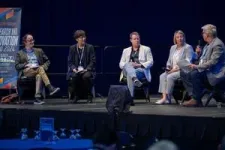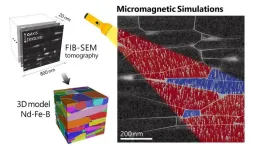(Press-News.org) The Ecological Society of America (ESA) presents a roundup of four research articles recently published across its six esteemed journals. Widely recognized for fostering innovation and advancing ecological knowledge, ESA’s journals consistently feature illuminating and impactful studies. This compilation of papers explores fire hazards in Mediterranean cork oak woodlands, putting theory to work predicting where cold-blooded organisms will occur under climate change, barriers to going high-tech in rangeland management and more, showcasing the Society’s commitment to promoting cutting-edge research that furthers our understanding of the natural world.
From Ecological Applications:
Browsers put a cork in Mediterranean woodland fire risk
Author contact: Miguel N. Bugalho (migbugalho@isa.ulisboa.pt)
Mediterranean oak woodlands are the original home of the world’s cork trees, but they are increasingly threatened by shrub encroachment and intense fires. At the same time, deer numbers have been on the rise throughout the Iberian Peninsula primarily due to land abandonment and an absence of predators. Focusing on the ways in which interactions among drought, shrub encroachment and deer impact Portuguese woodlands, the authors found that deer can reduce the risk of fire in these unique ecosystems. By browsing on encroaching shrubs, deer kept shrub expansion in check, which reduced fuel loads and lessened fire hazards. After 18 years, woodland plots that were fenced to keep deer out had denser thickets of shrubs—more fuel for fire—than neighboring unfenced plots where deer were free to browse. Based on these results, the authors conclude that control of understory vegetation by deer and other browsers can play an important role in shielding Mediterranean woodlands from intensifying fire conditions as the world warms.
Read the article: Ungulates mitigate the effects of drought and shrub encroachment on the fire hazard of Mediterranean oak woodlands
From Ecology:
Novel framework predicts where species will occur under climate change
Author contact: Margaret W. Simon (mwsimon@ku.edu)
Move over, birds and mammals—most animals on Earth, including nearly all pests and pathogens, are cold-blooded and unable to internally regulate their body temperature. Climate change is expected to directly impact where these species live, how many there are, and which new pests or diseases invade. To predict these impacts, this study examines how temperature affects different traits of cold-blooded animals and how these traits, in turn, influence their populations. By creating a model that considers how traits like growth rate and reproduction respond to temperature changes, the research team can predict where species can survive as temperatures shift. The model is general enough to work for many types of cold-blooded animals, from insects to fish to reptiles, and can even apply to conditions other than temperature, like humidity or salinity. By understanding these temperature effects, we can better anticipate how climate change will affect ecosystems, including which species might thrive or struggle in new conditions.
Read the article: Predicting the fundamental thermal niche of ectotherms
From Frontiers in Ecology and the Environment:
Wider use of technology would aid rangeland management
Author contact: Brandon T. Bestelmeyer (brandon.bestelmeyer@usda.gov)
With accelerating development of new digital tools like monitoring databases, online maps, virtual fencing, mobile applications and more, land management is going high-tech—or, at least, it has the potential to do so. For managers of the world’s rangelands, numerous web-based instruments have been introduced in recent years that could significantly improve, if not revolutionize, development of effective management and response strategies. But what good are these marvels of the modern age if rangeland managers can’t access, are unfamiliar with or have little confidence in such tools? The authors of this article contend that social networks of managers, scientists and technology experts will be crucial if rangeland management is to keep pace with technological innovation and adapt to a changing world.
Read the article: Fulfilling the promise of digital tools to build rangeland resilience
Tips for managing landscapes reshaped by wildfire
Author contact: Kimberley T. Davis (kimberley.davis@usda.gov)
Natural landscapes have historically been shaped by wildfire, but changing climate conditions are driving rapid shifts in how often and how intensely fires burn. These changing fire regimes can trigger large-scale changes in many ecosystems. Post-fire transitions from forest to scrubland, or from native sagebrush to invasive grasslands, have been well documented throughout the western U.S. However, the authors of this study argue that too little of this research has focused on whether conventional management approaches can meet the complex challenges posed by these altered ecosystems. They advocate for greater collaboration among managers, scientists and Indigenous communities, along with additional pre- and post-fire research, expanded monitoring and greater exchange of information among stakeholders.
Read the article: Centering sociological connections to collaboratively manage post-fire vegetation shifts
###
The Ecological Society of America, founded in 1915, is the world’s largest community of professional ecologists and a trusted source of ecological knowledge, committed to advancing the understanding of life on Earth. The 8,000 member Society publishes six journals and a membership bulletin and broadly shares ecological information through policy, media outreach and education initiatives. The Society’s Annual Meeting attracts 4,000 attendees and features the most recent advances in ecological science. Visit the ESA website at https://www.esa.org
Follow ESA on social media:
Twitter/X – @esa_org
Instagram – @ecologicalsociety
Facebook – @esa.org
END
Dr James Gill, a Clinical Lecturer at the University of Warwick and a practising GP, will attend a pivotal event hosted at the House of Lords on Monday (April 29) focused on combating the global crisis of antimicrobial resistance (AMR).
Antimicrobial resistance poses a formidable threat to communities worldwide, with projections indicating that by 2050, over 10 million deaths annually could be attributed to AMR, surpassing even the toll of cancer. In the face of this escalating emergency, effective communication is paramount. Health professionals and organisations play a crucial role in disseminating accurate, accessible information to raise awareness about critical ...
The case of a Florida bottlenose dolphin found with highly pathogenic avian influenza virus, or HPAIV — a discovery made by University of Florida researchers in collaboration with multiple other agencies and one of the first reports of a constantly growing list of mammals affected by this virus — has been published in Communications Biology.
The report documents the discovery, the first finding of HPAIV in a cetacean in North America, from the initial response by UF’s Marine Animal Rescue team to a report of a distressed dolphin in Dixie County, Florida, to the subsequent identification of the virus from brain and tissue samples obtained in a postmortem ...
The same geometric quirk that lets visitors murmur messages around the circular dome of the whispering gallery at St. Paul’s Cathedral in London or across St. Louis Union Station’s whispering arch also enables the construction of high-resolution optical sensors. Whispering-gallery-mode (WGM) resonators have been used for decades to detect chemical signatures, DNA strands and even single molecules.
In the same way that the architecture of a whispering gallery bends and focuses sound waves, WGM microresonators confine and concentrate light in a tiny circular path. This enables WGM resonators ...
NEWPORT NEWS, VA – On April 18, the U.S. Department of Energy’s Thomas Jefferson National Accelerator Facility welcomed Under Secretary for Science and Innovation Geraldine (Geri) Richmond for a tour of the lab and briefing on its research mission, innovation and STEM programs.
Throughout the day, much of the conversation centered on a common theme of how the lab is working to ensure it is a hub of engagement, partnership, and access for researchers, students, community leaders and others. Ensuring diverse communities have access to the programs, ...
Hundreds of faculty, students and business leaders flocked to The University of Texas at Arlington for its second annual Research and Innovation Expo, an event designed to showcase the University’s research efforts.
“This is an event where we can showcase our research achievements and encourage everyone to learn about and engage with other investigators outside their own fields,” said Eileen Clements, interim executive director of the UT Arlington Research Institute and an organizer of the event.
Researchers learned how ...
By Leah Shaffer
A new imaging technique developed by engineers at Washington University in St. Louis can give scientists a much closer look at fibril assemblies, stacks of peptides like amyloid beta, most notably associated with Alzheimer’s disease.
These cross-β fibril assemblies are also useful building blocks within designer biomaterials for medical applications, but their resemblance to their amyloid beta cousins, whose tangles are a symptom of neurodegenerative disease, is concerning. Researchers want ...
The University of Texas MD Anderson Cancer Center and RUSH University System for Health today announced a partnership to create RUSH MD Anderson Cancer Center. The partnership represents advanced clinical and operational integration in the delivery of cancer care, providing RUSH patients greater access to cancer treatments and research considered among the best in the world.
MD Anderson is one of the nation’s leading cancer centers and its team of experts is devoted exclusively to cancer patient care, research, education ...
1. NIMS has succeeded in simulating the magnetization reversal of Nd-Fe-B magnets using large-scale finite element models constructed based on tomographic data obtained by electron microscopy. Such simulations have shed light on microstructural features that hinder the coercivity, which quantifies a magnet’s resistance to demagnetization in opposing magnetic fields. New tomography-based models are expected to guide toward the development of sustainable permanent magnets with ultimate performance.
2. Green power generation, electric transportation, and other high-tech industries rely heavily on ...
A new study highlights possible cardiovascular health advantages in individuals with a rare condition known as growth hormone receptor deficiency (GHRD), also called Laron syndrome.
GHRD, which is characterized by the body’s impaired ability to use its own growth hormone and results in stunted growth, has been linked in mice to a record 40% longevity extension and lower risks for various age-related diseases. However, the risk of cardiovascular disease in individuals with GHRD has remained ...
When did you last go anywhere without your cell phone? From maps and weather apps to social media platforms, we give consent for our phones to trace our footsteps and behavior. These curated mobility data are often used for personalized advertisements. In a commentary, published April 26 in the journal Cell Reports Sustainability, scientists argue mobility data can offer so much more—it is key to understanding human-wildlife interactions for guiding policy decisions on sustainability-related issues and should be free and accessible for research.
As ...







